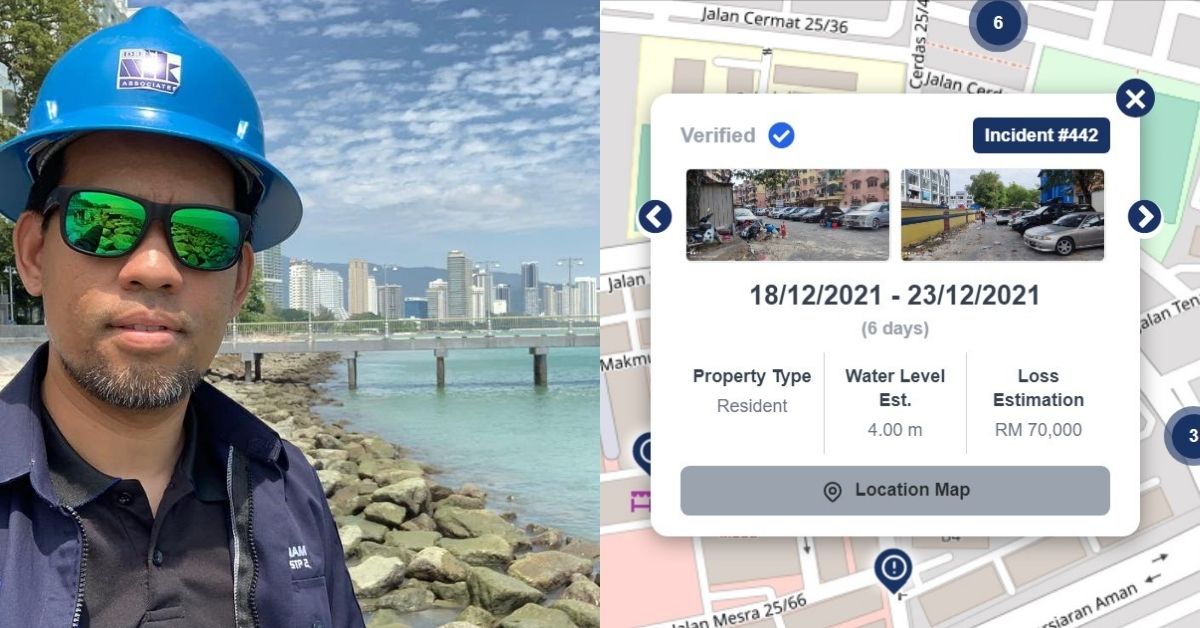It’s been over 2 weeks since Malaysia’s tragic floods began just after mid-December 2021, but there appears to still be no end in sight.
Most recently, Johor has been hard-hit by the floods, with almost 4K people now displaced. Residents in coastal areas along Peninsular Malaysia have also been advised to be on alert for high tides within this week.
The government is now working on completing an early warning system for flooding called the National Flood Forecasting and Warning Centre (PRABN) system by 2023. It claims that this will give Malaysians a two-day alert prior to a forecasted disaster.
But we’ve seen that our fellow Malaysians aren’t ones to sit around and do nothing as their peers attempt to recover from the damage dealt by the floods, or continue to face the phenomenon.
Thus, Muaz Kamel, Director (Coastal & Hydraulics) at consultant engineering firm Dr. Nik & Associates (DNA) together with the team at Ifcon Technology have introduced a site called BencanaBanjir.com.
The site was created in the span of one day, and the team is continuing its improvement of the system.
Meet the team
This initiative appears to be spearheaded by Muaz, who’s a professional engineer experienced in marine and hydraulics-related work in countries with lands that are below sea level, such as the Netherlands.
At DNA, he and his team conduct research on flood disasters both domestically and abroad. Despite flood research being their forte, even he admitted that the floods in December 2021 left his team shocked.
It broke expectations and the data records they had. According to their research, a phenomenon of this scale happens only once every 100 years. But it’s likely that due to climate change, these natural disasters will begin getting more unpredictable.
Hence, being able to gather and analyse the current data is important for the team to create frameworks and aid the government authorities in developing a more robust infrastructure for the future.
Though the authorities are gathering data with their own methods, getting the information straight from the affected communities is much faster and can be more accurate, if done in good faith.
What does it do?
The goal of BencanaBanjir.com is to gather crucial data from those on the ground in flooded areas in order to create a more accurate and authentic analytical database of the floods.

Once the team has that data, it can be shared with the authorities for improved planning to reduce and prevent fatalities, damages, and losses related to floods.
Essentially, the site is a crowdsourced database, and as of December 26, 2021 (3 days after its launch), it had collected over 500 reports from victims.
How does it work?
If you’re in a flood-affected location, these are the 5 simple steps.
- Head to the BencanaBanjir.com site which is available on PC and mobile browsers.
- Select your language: Bahasa Melayu, English, Mandarin, or Tamil.
- Set the location of the flood incident you want to report on the map.
- Click “Report Incident” and fill up the necessary information, and include relevant pictures.
- Once you’ve reported the incident, you’ll get an SMS prompt to verify your report.
On the map, you’ll be able to see multicoloured dots that indicate the number of reports across an area and click on each one to see more details.
A new feature that was added just yesterday is the warning and alert system that utilises data from the Department of Irrigation and Drainage (JPS) and translates it into simple map indicators.

At a glance, this gives users an immediate sense of what areas are seeing dangerous water levels, what the status of the floods currently are, and more, so they can make necessary plans.
The damage has been done, but future incidents can be prevented
Climate change activist Shaqib Shahril has estimated that the total losses incurred during the recent floods could amount to at least RM20 billion.
This amount is based on estimates of damages sustained by households and residential areas as well as businesses and industries.
But the monsoon season has not yet peaked, and experts will need more data before finalising the financial implications of the floods later.
Based on the current data BencanaBanjir.com has been collecting, reports that shared loss amounts have given the team an average of RM40K loss per location. With many reports still lacking a shared loss amount though, it’s likely the number may be higher.
BencanaBanjir.com is a good first start to making flood data accessible and more easily understandable for Malaysians, but again, other than enabling us to plan for evacuation or cleaning efforts, there’s not much else the public can do with the data.
The onus is on the government and its responsible agencies to utilise the data and come up with better frameworks and infrastructure to prevent a repeat of what happened starting from December 16, 2021.
- Learn more about BencanaBanjir.com here.
- If you’re looking for flood relief fundraisers, head here. To get an idea of how you can effectively volunteer at flooded areas, read this.
Featured Image Credit: BencanaBanjir.com











